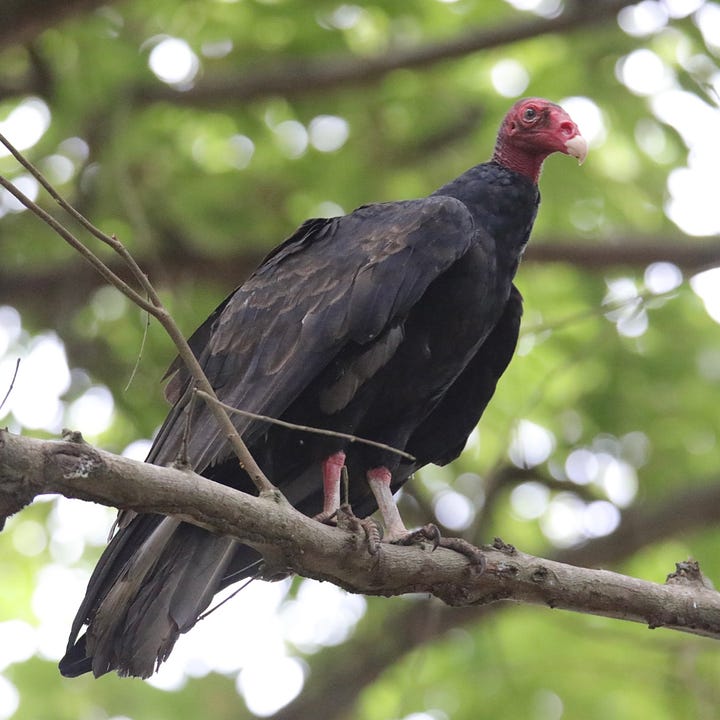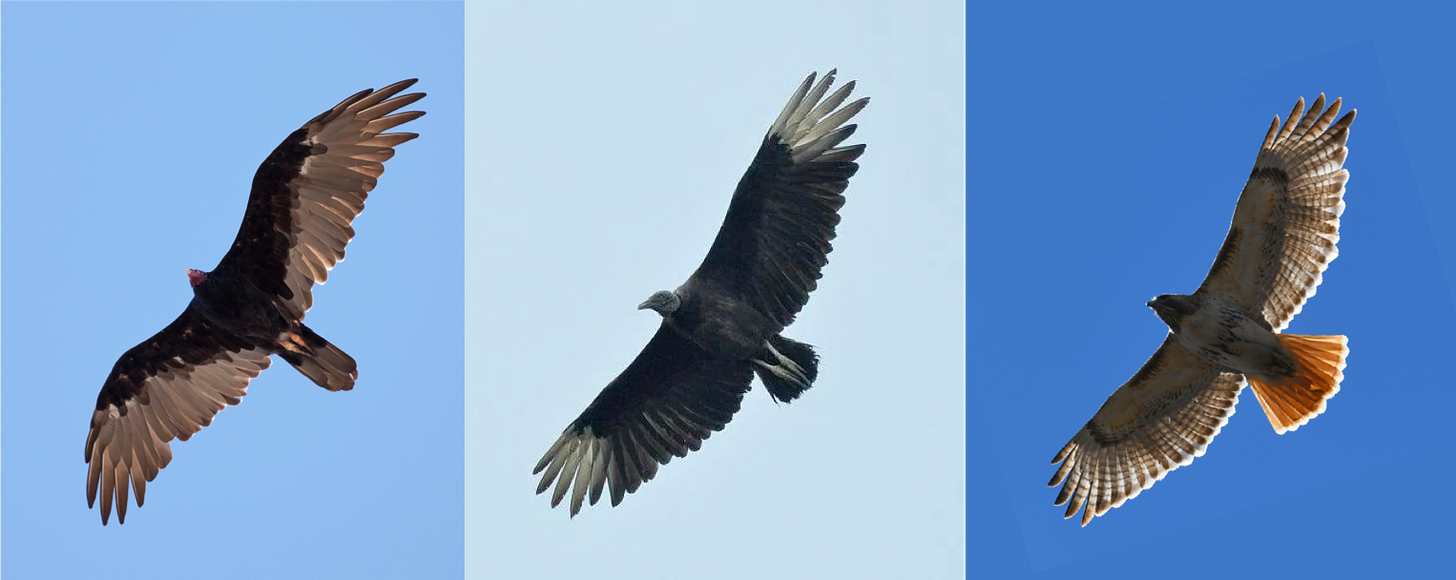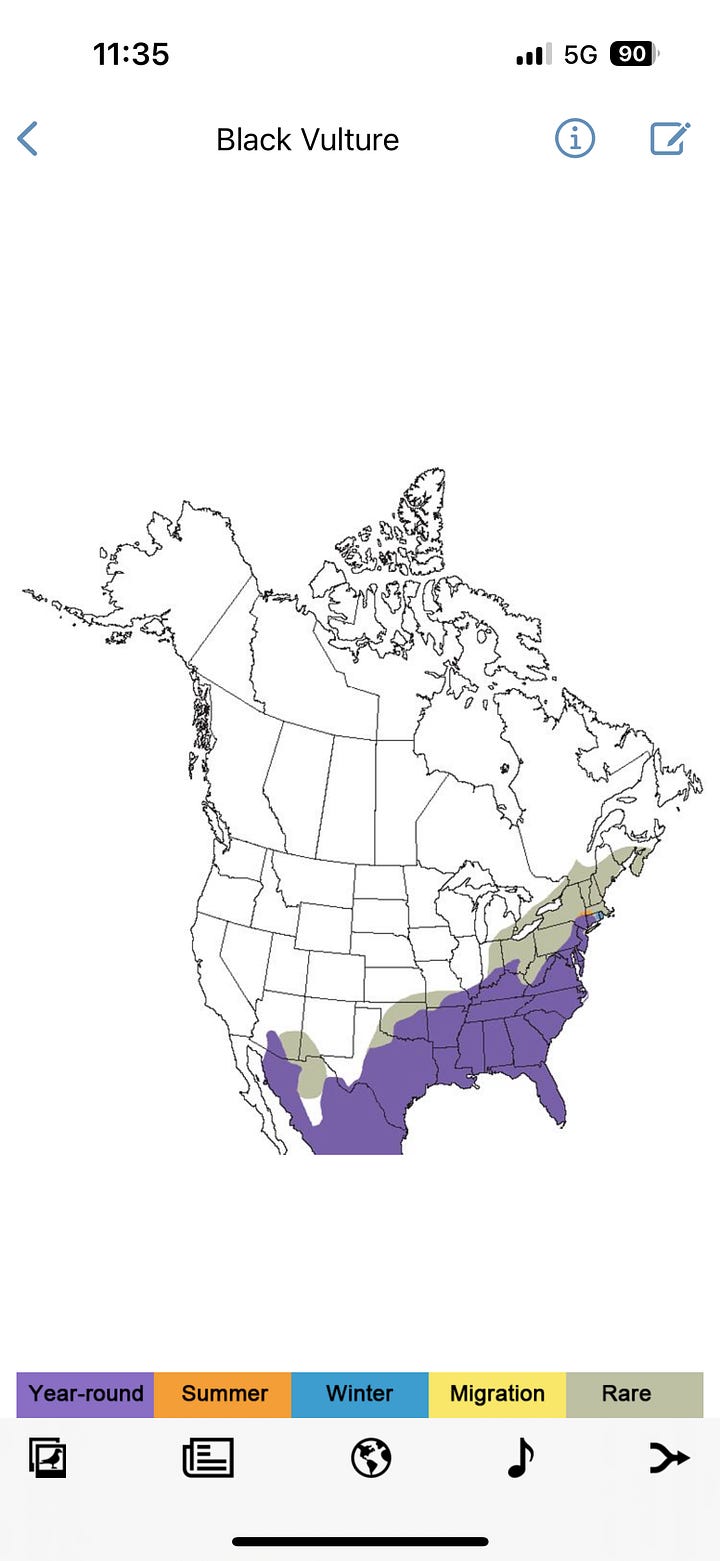MICRO-SEASON — AUG 12 - AUG 18
Ticket Winners & The Penultimate Fall Warbler Lesson & Rehashed Vultures
There are few stranger sights than a walking human absorbed by their phone. Our brains are designed to release dopamine when we do something that meets a survival need, like finding communal safety or eating or having sex. Countless studies have shown that phone activity, with its pixel friends and junk food info and erotic holograms, co-opts the same mechanisms, making us feel motivated, happy, and aroused.
For a moment. Like a drug.
UPDATES & ANNOUNCEMENTS
If you were lucky enough to get in on our latest group discount, courtesy of Nocs Provisions, you can now pick your goodies up at a Saturday walk, or else DM us to arrange a handoff!
Baddies Erin and Tammy correctly identified the “mystery warblers” we carousel’d here. As promised, alongside other trinkets, they each received 2 tickets to Nonhuman Teachers’s SOLD OUT August 21st event, HORT/CULTURE: featuring John Wilson (of the HBO show!) + musician Molly Lewis. Bravo!
Unfamiliar with John Wilson? Talk about noticing
How about Molly Lewis? Yeah, it’s gonna be a wonderfully weird night
MICRO-SEASON AUG 12—AUG 18
“We’re always looking for something, waiting for something—for the time which will be perfect, peaceful, better, different, happy. But we’re not suddenly going to find some mysterious place where all our troubles disappear. Our great life truly is just what we are at this very second.” ― Charlotte Joko Beck

Current Japanese micro-season: Evening cicadas sing. As for McGolrick Park, perhaps New York City and even larger swathes of the eastern US, we notice—
Lesser burdock flowers · Eastern wood-pewee returns · First Fall Redstarts · Post-bloom forest floors
Lesser burdock is an invasive weed and a source of gardeners’ ire [source]
Burdock produces purple flowers in its second year of growth, from July to October. After the flower head dries, hooked bracts can attach to humans and animals to transport seed-heads [source]
Lauren C. and Lisa B., North Brooklyn Parks Alliance’s masterful hort-heads, made us hip to the fact that McGolrick’s London plane trees, while providing grateful parkgoers with expanses of shade, also create conditions typical to a forest understory or floor. For that reason, summer flowers lacking direct sunlight can stop blooming ‘round this time of year. Meaning the remaining flowers are mostly longer-blooming perennials like Wild Hibiscus
AUG 17, 2024 — SATURDAY
Conditions: Storms-a-brewin’ • Attendance: ~70 • Vibrations: Present
Saturday birds: Black-and-white Warbler · American Redstart · Eastern Wood-Pewee · Common Grackle · Chimney Swift · Carolina Wren (heard)… And our 5 urban park besties: Rock Pigeon · European Starling · American Robin · House Sparrow · Mourning Dove
Pic of the day:
SHORTY-LESSON: FALL WARBLERS
Our springtime warbler lesson that covered the ~25 commonest-to-NYC warbler species was only a first half!
In fall, breeding male warblers shed spring’s bold fits for feathers that have them looking just like females and juvenile males. These lewks are what we’ll primarily notice when, beginning in mid-late August, migrating birds pass back through NYC en route to southern wintering grounds.


Blackburnians! Their black and burnin’ hot orange masks go yellow-orange in fall. We’re looking for yellow-orange fronts with residual, faded gray eye marks and caps.


Pines are best known for their yellow spectacles on dingy yellow overall. These birds lose colors in fall and, like last week’s Yellow Warblers, can really land anywhere on the gray-yellow continuum. Look especially for remaining evidence of those specs, including a just broken eye-ring.


Like Ovenbirds, Waterthrushes don’t fit the classic perching bird template one comes to expect of warblers NOR do they change plumage for fall. Look for them low, near water, vigorously pumping their tails. Northerns will need to be distinguished from Louisiana Waterthrushes, who are identical save Northerns’ neck stripes and more off-white, yellow-ish washes.


Ready to get tricky?! Blackpolls trade their caps and black dappling for olive-yellow fronts. Note their still barred, slightly olive wings and, crucially: YELLOW LEGS.


Fall Bay-breasted Warblers can be identical to Blackpolls, ‘cept for darker legs! (So get your binoculars on them pretty non-yellow stems.) Too, fall bays occasionally still rock remnants of their namesake breasties. So be on the lookout for faded brown side-stripes.
Feeling flustered? Reply to this email with questions! And take heart: images are always harder to absorb than IRL experiences, which you’ll have—perhaps alongside us, should we be so lucky—soon enough. The important thing is to TRY. FAIL. TRY AGAIN. BE HUMBLED. And remember: YOU WERE MADE TO DO THIS.
MICRO-REHASH: VULTURES
This micro-lesson originally appeared in our June 10 - 16 Micro-Season. We’re rehashing because the likelihood of seeing a vulture soaring over NYC is about to go back up. And repetition is like, the auntie of knowing.. or something.
How does your correspondent anticipate the reappearance of vultures? Check Prospect Park’s bird likelihood bar charts, mate. That park, with its large size, myriad habitats and numerous birders, mean its eBird data is a decent predictor of Brooklyn bird activity at large. Exercise: What other species via the above link to reappear in Kings County, come mid-August? DM us your finding(s) and we’ll throw you a tee or somethin’ neato for your efforts.
Like Kinglets or Nuthatches, it’s always comforting when you only have to memorize a handful of species per bird type.
‘Tis the case for US vultures. You’ve got your Black Vulture. You’ve got you’re Turkey Vulture. Ya Donezo.


Before we learn how to tell them apart, let’s first acknowledge the stinky, deceased elephant in the room: vultures, technically birds of prey, eat the decaying flesh of dead animals.
Chorus of kids: Ewww!
Your correspondent: Shut up, children! Vultures are sick! (In, like, the Californian radical/cool sense, bra.)
Sick Vulture Facts
- Vultures are—#relatable—sensitive creatures. Their keen eyesight, superior noses (rare in the bird of prey world), and, according to recent research, recognition of sounds associated with hunts, all help them find feeding opportunities
- A group of carcass-eating vultures is called a wake
- Vulture stomach acid is so butch that it can handle bacteria as wacky as anthrax. Bonus here is vultures remove bio-hazardous toxins from their environments
Identification from Below
Vultures are huge birds who soar like hang gliders. Other large birds like the common Red-tailed Hawk soar too. But, much like said gliders, vultures more delicately balance their wings as they surf warm waves of air.
Let’s also tell them apart via their different sizes, patterns and shapes. Notice:

Head — Vultures, unlike hawks, have small heads relative to their huge wings. Turkey Vultures’ heads are pink. Black Vultures’: black. Those colors can of course be hard to see if the vultures are way up high.
Plumage — Turkey Vultures’ coloring, as clubber Palmer remarked, give a T or V-ish shape. T or V for .. turkey and vulture. Yeah? Black Vultures are all black, ‘cept for white “fingertips”. Red-tailed Hawks can have variable plumages, but red-orange fantails and dark shoulders—see graphic here—are distinctive.
Tail shape — Blacks Vultures’ tails are shorter than Turkeys’. Red-tails’ tails are stubby and often fanned mid-soar.
Range — Turkey Vultures are the more common US vulture, especially because the Black’s range is limited to the south and east. Both are technically year-round New Yorkers, but experience and data (like this) show Turkeys to be more noticeable:


Bonus: California Condor
What about condors? Aren’t those vulture-y birds? They are! Condors and vultures are related. Condors are bigger. Also less common: the California and Andean Condors, both New World birds, are the only two condor species in the world.
In the US, there’s just the California Condor. That nearly extinct species is being actively re-introduced at specific sites in California and Arizona. Very rare to see one soaring beyond, and even within, those locations.
California Condors look a bit like Turkey Vultures, but are bigger, and their plumage shadings are inverted, giving condors a sort of a boney look. They also, for the sake of conservation science, sport alphanumeric tags on their wings.





